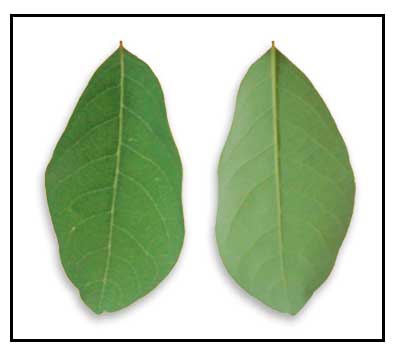|
 Botany Botany
Kuliak-daga is a shrub or a small tree growing up to 2 to 5 meters. Branches are somewhat hairy and armed with sharp, slender axillary spines 5 to 10 millimeters in length. Leaves are ovate to elliptic-ovate, 1 to 2.5 centimeters long, short-petioled, and pointed at both ends. Flowers are greenish-yellow or nearly white, about 6 millimeters long, borne singly in the axils of the leaves. Fruit is red, fleshy, ovoid, about 7 millimeters long.
 Distribution Distribution
- Found in dry thickets
at low altitudes in Pangasinan, Zambales, Bulacan, Rizal, Camarines, and Sorsogon Provinces in Luzon.
- Also occurs in Burma to Malaya.
- Sometimes used as hedge plant.
Parts used
Leaves and bark.
Constituents
• Phytochemical study showed
the roots to predominantly consist of triterpenes, alkaloids, anthraquinones,
steroids, organic acid, phenols and carbohydrates.
• Study of essential oils from C. horridum yielded 27 peaks and identified 26 compounds. The main components were 1,2-benzenedicarboxylic acid bis(2-methylpropyl) ester (36.08%), bis(2-ethylhexyl) phthalate (13.82%), n-hexadecanoic acid (8.32%), (Z,Z,Z)-9,12,15octadecatrien-1-ol (9.61%) among others. (1)
• Study of CH stems yielded ten compounds: syringaresinol, scoparone, scopoletin, 3'-methoxy-4'-hydroxy-trans-cinnamaldehyde, sinapic aldehyde, syringic acid, mannitol, vanillic acid 4-O-beta-D-glucopyranoside, beta-daucosterol and beta-sitosterol. (see study below) (3)
• Study of stem extract isolated 20 compounds:
syringaresinol (1), quercetin(2), scoparone(3), scopoletin(4), fraxidin(5), sinapic aldehyde(6), 3-methoxy-4-hydroxy-trans-cinnamaldehyde (7), coniferyl alcohol (8), p-hydroxybenzoic acid (9), vanillic acid (10), syringic acid (11), syringaldehyde (12), di-isobutyl phthalate (13), vanillic acid 4-O-β-D-glucopyranoside(14), 3-(1-C-β-D-glucopyranosyl)-2,6-dihydroxy-5-methoxybenzoic acid (15), mannitol (16), β-daucosterol (17), β-sitosterol (18), nonadecanoic acid (19), dibutyl phthalate (20). (see study below) (8)
• Bioassay-guided study of stem extract of C. horridum yielded ten compounds: (+)-syringaresinol (1), scoparone (2), scopoletin (3), 3'-methoxy-4'-hydroxy-trans-cinnamaldehyde (4), sinapic aldehyde (5), syringic acid (6), mannitol (7), vanillic acid 4-O-beta-D-glucopyranoside (8), beta-daucosterol (9), and beta-sitosterol (10). (see study below) (10)
 Uses Uses
Edibility
· In Java, confections are made from the acid fruit.
Folkloric
• In the , boiled leaves and bark used to hasten menstruation.
• In Malaya, plant is used for wounds and fevers.
• In Indo-China, bark and young twigs used for dysentery.
• Decoction also used after childbirth.
• In Indonesia, used to soothe inflamed eyes. In Malaysia, used to heal wounds and promote recovery from childbirth. (7)
• In
Vietnam bark and young stems used to treat dysentery. (7)
• In China, folk healers of the Lahu people apply mashed leaves on snake bites. Plaster from mashed leaves used for
foot pains.
• In China, used for cough, diabetes and hypertension. (11)
• Boiled fruits used to treat foot wounds.
Studies
• Anti-Bacterial: Study
isolated compounds found for the first time, Carulignan, lupeol, b-sitosterol,
among many others. The chloroform fraction showed anti-bacterial activities.
• Phytochemicals / Antibacterial: Study
of the chemical composition of the roots of C horridum yielded triterpene, alkaloid, anthraquinone, steroid, organic acid, phenol, carbohydrates among others. The chloroform fraction was shown to have antibacterial properties. (2)
• Constituents / Antimicrobial: Study of CH stems yielded ten compounds: syringaresinol, scoparone, scopoletin, 3'-methoxy-4'-hydroxy-trans-cinnamaldehyde, sinapic aldehyde, syringic acid, mannitol, vanillic acid 4-O-beta-D-glucopyranoside, beta-daucosterol and beta-sitosterol. Siringic acid had the highest activity against Bacillus subtilis; syringaresinol showed good activity against E coli, B subtilis and S aureus. (3)
• Phenolics / Antioxidant: Study
of leaves showed the polyphenol content of 0.4879%. Results show the leaves had strong antioxidant activity, with an IC50 value of 0.35mg/mL. (5)
• Antibacterial / Stems: Bioassay-guided isolated studies of stem extract isolated 20 compounds. Compound 1 showed high inhibitory activity against Escherichia coli, Bacillus subtilis and Staphylococcus aureus. Compounds 3 and 7 had medium activity against these bacteria. No compounds showed activity against Aspergillus niger. (8)
• Antimicrobial / Stem: Bioassay-guided study of C. horridum stem extract yielded ten compounds. Compound 6 showed highest activity against Bacillus subtilis, while compound 1 should good activity against E. coli, B. subtilis and S. aureus. No compound showed activity against Aspergillus niger. (see constituents above) (10)
Availability
Wild-crafted.
|


 Botany
Botany Distribution
Distribution Uses
Uses

